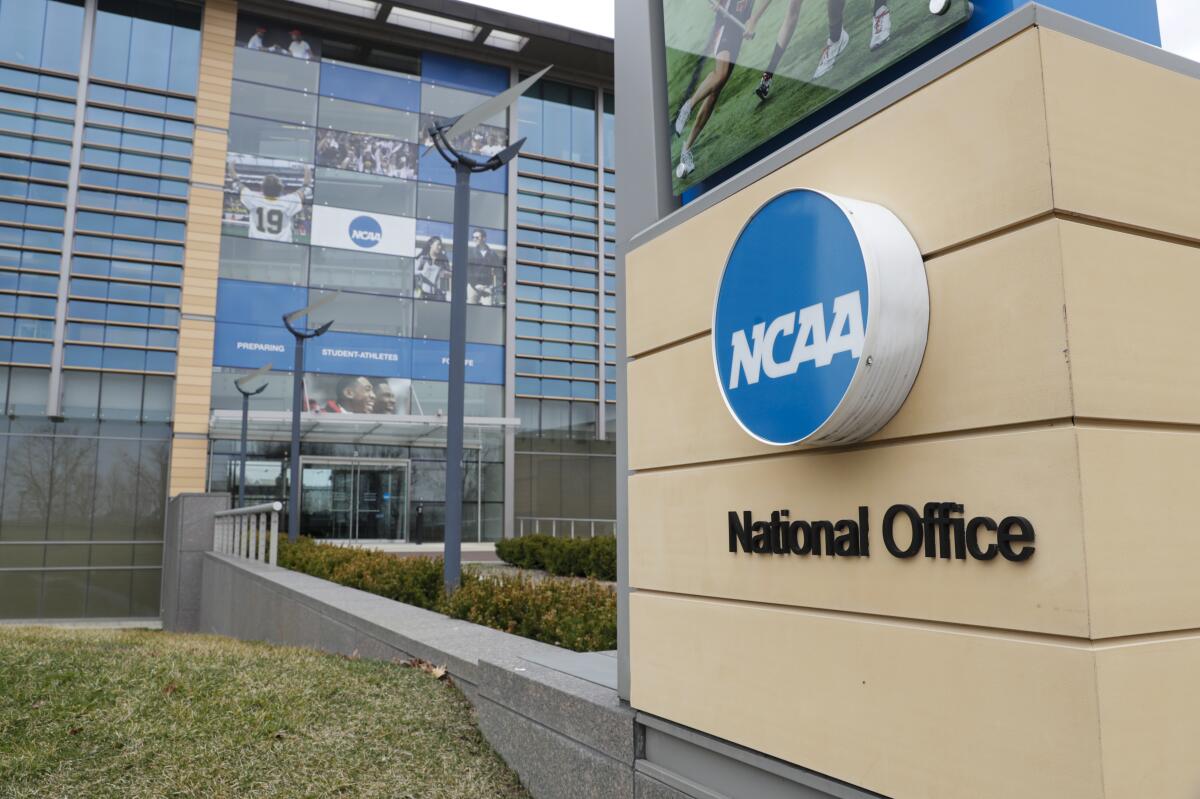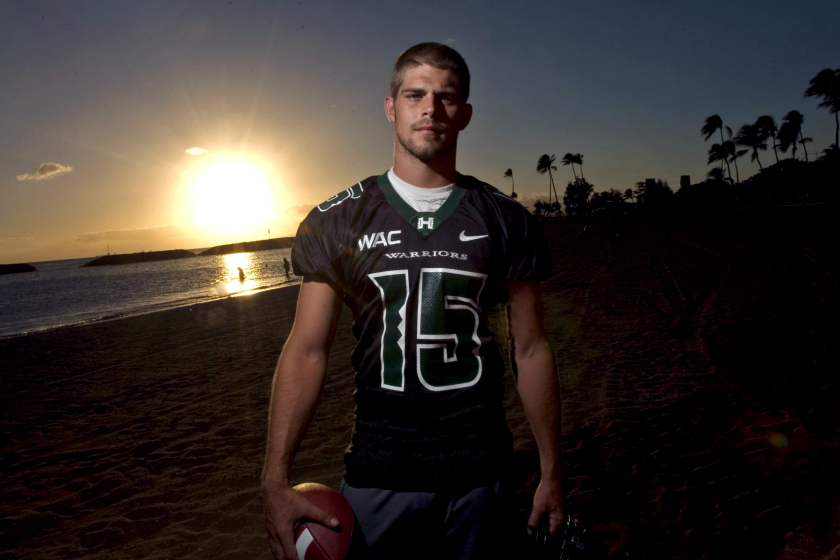L.A. jury finds NCAA is not responsible for death of former USC linebacker Matt Gee

- Share via
A jury ruled Tuesday that the NCAA is not to blame for the death of former USC linebacker Matthew Gee, a decision that could have broad implications in numerous other cases lined up against the governing body of college athletics.
Gee’s attorneys could not convince the jury in Los Angeles Superior Court that the NCAA failed to protect him from repetitive head trauma that led to his death, which was ruled by the coroner to be caused by cardiac arrest and that acute alcohol and cocaine toxicity were contributing factors. Jurors, who deliberated only one day before rendering their verdict, did not believe chronic traumatic encephalopathy (CTE) led to Gee’s death or that the NCAA was negligent in failing to inform Gee of the risks of repetitive head trauma.
Gee died in his sleep at age 49 at his Simi Valley home Dec. 31, 2018. Alana Gee, his widow, sought $54.8 million in damages for wrongful death and loss of her husband’s companionship based on her husband’s life expectancy.
The case was the first in which a jury decided whether hits to the head in college football led to CTE and death. A 2018 case in Texas made it to trial but led to a settlement after several days of testimony.
Other cases have been settled before trial and, according to experts, many more are being prepared by plaintiffs who believe the NCAA should be held accountable for the repetitive brain trauma they or family members suffered while playing college football.
“We are gratified that the jury, after considering four weeks of evidence and testimony, agreed overwhelmingly with our position in this case,” Scott Bearby, NCAA senior vice president of legal affairs and general counsel, said in a statement. “The NCAA bore no responsibility for Mr. Gee’s tragic death, and furthermore, the case was not supported by medical science linking Mr. Gee’s death to his college football career. We express our deepest sympathies to Mr. Gee’s family.”
A CTE expert who requested anonymity said the Gee verdict “doesn’t mean the door is closed for future cases, but it does mean the bar is higher. . . . There are much more powerful cases out there.”
Gee’s case was complicated by the myriad health issues that NCAA expert witnesses said caused or contributed to his death.
Alana Gee is suing the NCAA for $54.8 million for failing to protect her husband and former USC player Matthew from repetitive head trauma 30 years ago.
Testimony established that Gee had severe, untreated hypertension since 1991. He also had coronary artery disease that led to the cardiac arrest, including documented ventricular arrhythmias. His heart was enlarged. He had advanced liver disease, untreated sleep apnea and was obese.
Gee suffered from Klippel-Trenaunay syndrome (KTS), a rare congenital malformation involving blood and lymph vessels and abnormal growth of soft and bone tissue. KTS is extremely painful and, according to testimony, Gee a few years before he died asked a doctor to cut off his left foot because he couldn’t stand the pain.
Testimony from Gee’s family and friends established that as his behavior deteriorated, he went from being a loving, stable husband, father and provider to someone given to impaired judgment, aggression, confusion and depression. The plaintiff’s experts testified that the symptoms were caused by CTE.
The defense countered by describing Gee’s hepatic encephalopathy, a nervous system disorder brought on by severe liver disease that elicits symptoms similar to those triggered by CTE.
“That’s what Mr. Gee had,” NCAA lawyer Will Stute said during closing arguments. “. . . Shortened attention span, bizarre behavior, inappropriate behavior, muscular incoordination. ... Tremors, slurred speech, difficulty with concentration. ... The liver stops working and the brain is filled with confusion.”
Stute pointed to testimony from Alana Gee that her husband improved when he took medication for hepatic encephalopathy.
“CTE is supposed to be an unrelenting degenerative condition. There is no getting better,” Stute said. “The fact that he got better is significant because it’s not consistent with CTE causing those symptoms.”
Gee played linebacker for USC from 1989 to 1992 and led the team in tackles his junior and senior seasons. He was cut from training camp by the Los Angeles Raiders the following year after signing as an undrafted free agent and did not play in the NFL.
Gee and his future wife met while both were college students, married and settled in Northridge. They had three children and Gee built a successful insurance business. They eventually moved to Simi Valley.
Gee is one of five linebackers from the 1989 USC team to die before age 50. The others are Junior Seau, Scott Ross, Alan Wilson and David Webb. Seau, a 12-time Pro Bowl selection with the San Diego Chargers, and Ross died by suicide. All displayed behavioral and mood symptoms associated with repetitive brain trauma and CTE. However, testimony about the death of Gee’s teammates was not allowed at the trial.
No evidence was presented to prove that Gee suffered a concussion at USC — or any other time. His parents testified that they don’t recall him having a concussion playing youth or high school football. They — and Alana Gee — testified that Matt never said he suffered a concussion while at USC. And before a tryout with the Raiders, Gee filled out a form that asked if he’d had a concussion. He checked “No.”
The only evidence that Gee suffered concussions was anecdotal. USC linebackers coach Tom Roggeman, who served as a Marine in Korea, was described as a taskmaster who relished hitting drills in practice. Former USC teammate Mike Salmon, brother of longtime Angels outfielder Tim Salmon, recalled Gee’s state of mind during practices and games.

“Matt hit like a truck,” Salmon testified. “I saw him quite a bit coming back to the huddle. You could tell ... he wasn’t all there.”
Stute attempted to distance the NCAA from responsibility for disseminating information about CTE and protocols pertaining to dealing with concussions by asserting that its member schools were responsible — not the governing body. USC was not named as a defendant in Gee’s lawsuit.
Some NCAA witnesses, including former longtime UCLA team physician James Puffer, disputed that concussions lead to CTE. He testified that he doesn’t believe NCAA or even school officials must alert players to the risk of developing CTE.
“We don’t know with certainty at the present time that playing intercollegiate football irrefutably results in you developing CTE, or that playing intercollegiate football can lead to neurodegenerative disease,” Puffer told the jury.
“The NCAA continues to actively enhance player safety in collegiate athletics in its role as an athletic association,” Bearby said. “While the NCAA is not a medical body, it is at the forefront of funding the largest, independent study on the natural history of concussions in sports such as football. The NCAA is proud of its long track record of working to make sports safer in its role as an athletic association and will continue to aggressively defend against cases like this that wrongly try to exploit the legal system to unfairly target the NCAA.”
Gee’s attorneys called several prominent expert witnesses, including Dr. Robert Cantu, a neurosurgery specialist who is the medical director for the National Center for Catastrophic Sports Injury Research and co-director of the Center for the Study of Traumatic Encephalopathy at Boston University.
Cantu testified that Gee suffered from and eventually died from CTE and that playing college football was a substantial contributing factor in his death. Gee’s brain was examined by the UNITE Brain Bank at Boston University, which determined he suffered from Stage 2 CTE. Four progressive stages of CTE have been identified, with Stage 4 being the most severe.
“I believe a substantial contributing factor to his addiction was the CTE,” Cantu testified. “The CTE, I believe, was due to the trauma that his brain took while playing football, predominantly — not exclusively, but predominantly — at the college level. I believe the CTE is what caused him to not be able to better manage his addiction.”
Cantu pointed out that the National Institute of Neurological Disorders and Stroke (NINDS), part of the National Institutes of Health (NIH), in October formally acknowledged publicly for the first time that CTE is caused by repetitive traumatic brain injuries. Lawyers for Alana Gee estimated that Matt Gee endured about 6,000 hits during his four-year USC career.
Former Hawaii quarterback Colt Brennan was found to have had Stage 1 chronic traumatic encephalopathy, his family was told this week.
Evidence was presented that the NCAA might have deliberately destroyed documents that established the governing body knew more about the dangers of repetitive head injury and concussions to football players much earlier than stated. Stephen Casper, a professor and expert on traumatic brain injuries and concussions, testified that NCAA-produced journals from 1933 through 1966 are missing from the NCAA publications library, and that many of the journals include articles on what the NCAA had learned about the topic and recommended to curtail the damage.
Much of the testimony from Gee’s expert witnesses sought to establish that the NCAA had information about the adverse effects of concussions for decades that was not shared expediently with member schools or players. Even though the jury ruled that Gee’s death was not the responsibility of the NCAA, some experts believe the case established a foundation of alleged negligence that future cases can draw on.
The NCAA likely would call the same expert witnesses it did in the Gee case, and future plaintiffs would have an idea of their game plan.
NCAA witnesses “will testify the same thing from one case to another case,” said an expert who requested anonymity. “This kind of litigation is at its infancy, and while this jury determined there was not clear-cut causation, the next one might.”
More to Read
Go beyond the scoreboard
Get the latest on L.A.'s teams in the daily Sports Report newsletter.
You may occasionally receive promotional content from the Los Angeles Times.









